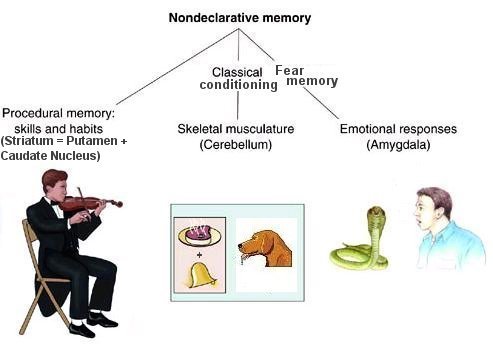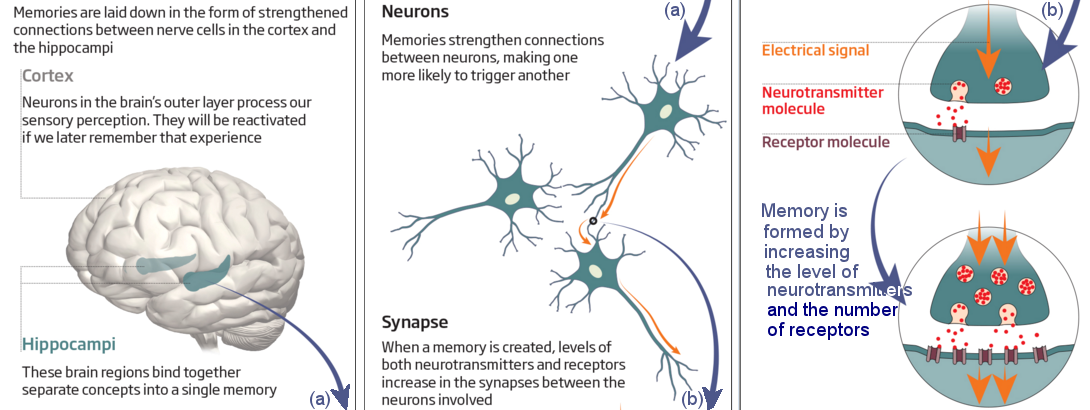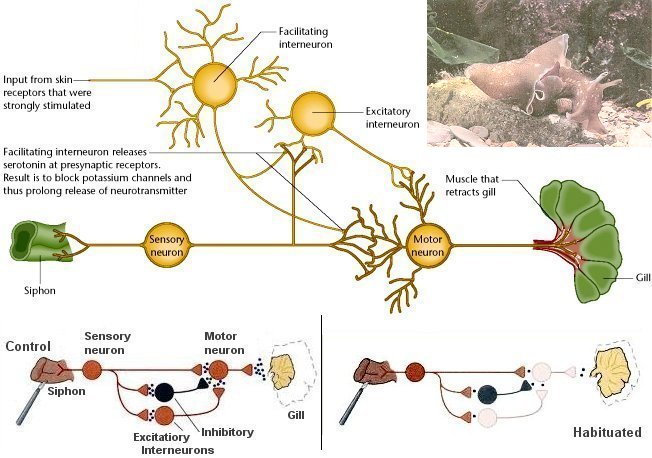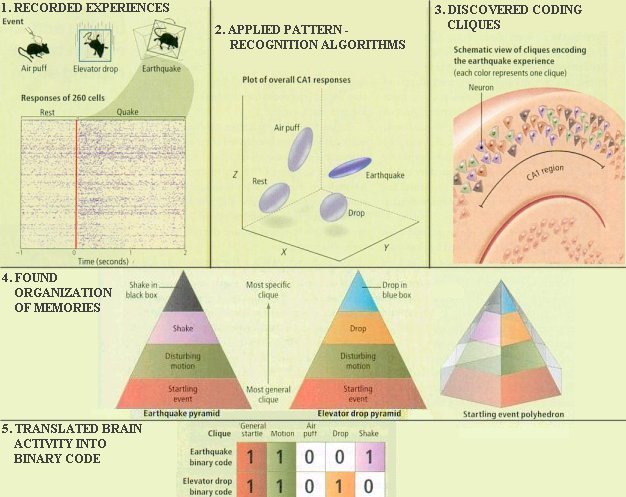
| Home Page | Overview | Site Map | Index | Appendix | Illustration | About | Contact | Update | FAQ |
 |
As shown in Figure 03a, the ability to modify our behaviour in response to life's experiences is shared by all animals including the bacteria E. coli. Such feat requires the brain's willingness to learn. Learning results in the formation of memories and in humans this process reaches its most sophisticated form, allowing us creatively to associate different reflections on the past, to generate new ideas, and most importantly to acquire language as a medium of expression and communication. Memory requires the brain to be physically altered by experience and it is this remarkable property that makes thought, consciousness, and language possible. The basic mechanism of memory formation is highly conservative over billion years of biological evolution. The difference in humans is that we have a lot more of the stuffs. There are about 100 trillion synaptic connections in our brain. |
Figure 24a Memory Classification |
 |
There are many ways to classify the memory. The concept of explicit and implicit memory refers to whether or not the recollection is produced consciously and intentionally. While the scheme of declarative and nondeclarative memory depend on the retrieval that can be declared verbally or not. Associative memory is triggered by clues; nonassociative memory can be habitual or sensitive. There are also short term and long term memory. One of the classification schemes is shown in Figure 24a. Table 07 is an attempt to put them all together. In the table, the declarative, and the procedural memory are explicit with the rest of nondeclarative memories being implicit. Only the working memory belongs to the category of short term memory fading away in hours, while the others are long term, and available for retrieval in years. Figure 24b shows the components, locations, and pathways for many types of memory. |
Figure 24b Types of Memory |
| Type | Location(s) | Function | Example(s) |
|---|---|---|---|
| Working Memory | |||
| Phonological Loop | Left hemisphere | Rehearsing verbal information to keep it in the short-term memory | String of numerals and alphabets such as telephone numbers |
| Visual-spatial Scratch Pad | Visual Cortex | Controlling visual imagery | Scanning text |
| Central Executive | Frontal lobe | Controlling awareness of the information in working memory | Constructing sentence, comprehending speech |
| Non-declarative Memory | |||
| Procedural Memory | Cerebellum, temporal lobes | Managing "how to" | Riding a bicycle, kungfu exercise |
| Classical Conditioning | Cerebellum | Forming habitual behaviour | Coffee break, afternoon tea |
| Fear Memory | Amygdala | Emotional conditioning | Phobias, flashbacks |
| Nonassociative Memory | Spinal cord | Habituation and Sensitization | Decreased or increased responsiveness to stimulus |
| Remote Memory (Priming) | Scattered around the cortex | Foundation for new memories | Childhood memory |
| Declarative Memory | |||
| Episodic Memory | Cortex | Remembering past experience | Some enchanted evening |
| Semantic Memory | Frontal lobe, temporal lobe | Registering facts | Meanings of words and symbols |
 |
to be remembered for a long time and must therefore be transferred to a more stable form of storage, which is represented by far more robust alterations in the brain's chemical and physical make-up in the form of synaptic connections. It is not necessarily for an important experience to trigger the formation of long-term memories, other factors such emotion, practice, and rehearsal also facilitate the transformation. Experiments show that in all cases the most important underlying distinction between the short- and long-term memory formation is that the latter requires a dialogue between synapses and genes and the former does not. |
Figure 25 Working Memory |
 |
|
Figure 26 Nondeclarative Memory |
Nondeclarative memory can be classified to five main groups : |
 Sensory Registration
Sensory Registration  Attention
Attention  Short Term Memory
Short Term Memory  Consolidation - Retrieval
Consolidation - Retrieval  Long Term Memory
Long Term Memory  Remote Memory. At the stage of sensory registration, there is a matching/assigning of the pattern to a meaning. Attention focuses the brain to a task by filtering out the noises. Short-term memory is temporary and is limited in space. If short-term memory is not repeated, the information is lost fairly quickly. Long term memory is consolidated and stored throughout the nervous system. Remote memories represent the foundation memories upon which more recent memories are built. Since early acquired information is the foundation for new memories and may be linked to many more new memories, such memory is less subject to change and/or loss. Similar to the short-term memory, the remote memories are not usually affected by aging.
Remote Memory. At the stage of sensory registration, there is a matching/assigning of the pattern to a meaning. Attention focuses the brain to a task by filtering out the noises. Short-term memory is temporary and is limited in space. If short-term memory is not repeated, the information is lost fairly quickly. Long term memory is consolidated and stored throughout the nervous system. Remote memories represent the foundation memories upon which more recent memories are built. Since early acquired information is the foundation for new memories and may be linked to many more new memories, such memory is less subject to change and/or loss. Similar to the short-term memory, the remote memories are not usually affected by aging. |
|
Figure 27 Long-term Memory |
Semantic, and episodic memory are the subclasses of declarative memory: |
 |
|
Figure 28a Declarative Memory |
 |
of huge number of inter-connecting neurons called "Cell Assembly". It is estimated that there are about 1 billion cells in a human hippocampus storing at least 10000 different concepts; therefore each one of them would involve 100000 hippocampi neurons. While the hippocampus plays an important role, memory in the cortex is an integrated part for handling action, thought, sensory perceptions, .... |
Figure 28b Memory Making |
 |
mechanisms and principles involved in its formation of short- and long-term memories are conserved throughout the animal kingdom, including in humans. Aplysia exhibits a behaviour of protective reflex in which the sea slug withdraws its gill into the safety of the mantel cavity in response to a mild touch stimulus to another part of the body called the siphon (Figure 29a). If the stimulus is repeated a number of times, the gill withdrawal reflex becomes weaker until finally the animal ignores the touch stimulus. The waning of sensitivity to repeated stimulation is known as habituation and is a very simple form of learning found in all animals, including humans. Another type of learning is sensitization, when we are exposed to an unexpected or strongly unpleasant stimulus. Generally the sensitizing effect of |
Figure 29a Memory in Aplysia |
a single alarming stimulus is short-lived, lasting perhaps for just a few minutes. But if the alarming stimulus is repeated a number of times our senses may be heightened for days and now such sensitization becomes a form of long-term memory. |
 |
As mentioned earlier, repeated activation yields a lasting increase in the efficiency of synaptic transmission -- a process called long-term potentiation (LTP) -- which is thought to underlie memory formation. LTP depends both on enhanced insertion of receptors for the neurotransmitter glutamate at spines (the sites of synapses) and on spine growth. Figure 29b shows the molecular basis of LTP as described in a 2008 neuroscience article. Essentially, it reports that the process is driven by the myosin V proteins, which shuttling receptors and membranes to make synaptic junctions better detectors of incoming signals. |
Figure 29b LTP, Molecular Basis of [view large image] |
A brief description for each step of the process is outlined in the following (also see Figure 29b): |
 |
 |
It is reported in 2007 that the seat of memory has been pinpointed in mouse. By monitoring 260 neurons in the hippocampus (Figure 29c), researchers have discovered that different experience is recorded in different area called "clique", which can be categorized from very general to very specific. Furthermore, such brain activities can be translated into binary codes (Figure 29d). Supposedly, we can read the mind from such codes and tell what it is thinking by the process of |
Figure 29c Seat of Memory |
Figure 29d Memory Code |
backward translation. The followings are steps to uncover the memory code: |
 |
An aplisa is like a squishy snail. In rain, in snow, in sleet, in hail. When it is angry, it shoots out ink. The ink is purple, it's not pink. An aplisa cannot live on land. It doesn't have feet so it can't stand. It has a very funny mouth. And in winter it goes to the south. |
[view large image] |